I’m tired of talking and thinking about my recent back surgery but if I’m going to post at all during my recovery I feel an obligation to occasionally provide my readers a very brief update. Suffice it to say that so far my recovery has been a bit of roller coaster but overall I’m still feeling optimistic about it going well and eventually getting at least some improvement from my original symptoms. Maybe I have already.
And I will say this – good neighbors, all close friends, have been incredibly helpful. By this evening I’ll have been out of the hospital for three days and I won’t have had to cook a single time because they’ve been providing food, good food, for which I’m very grateful.
One of the positive signs is that I sometimes feel well enough to want to post to my blog, even though it’ll be a while before I can go out shooting again, so that means posting older photos or rerunning older posts, or both. Most of today’s post, first published in 2014, is a rerun of one of my favorites because I found the behavior to be so unusual, if a little unsettling for some. For this version I’ve changed the title, edited the text and tweaked the formatting.
I believe this Swainson’s Hawk was taken by surprise by what it found in its mouth.
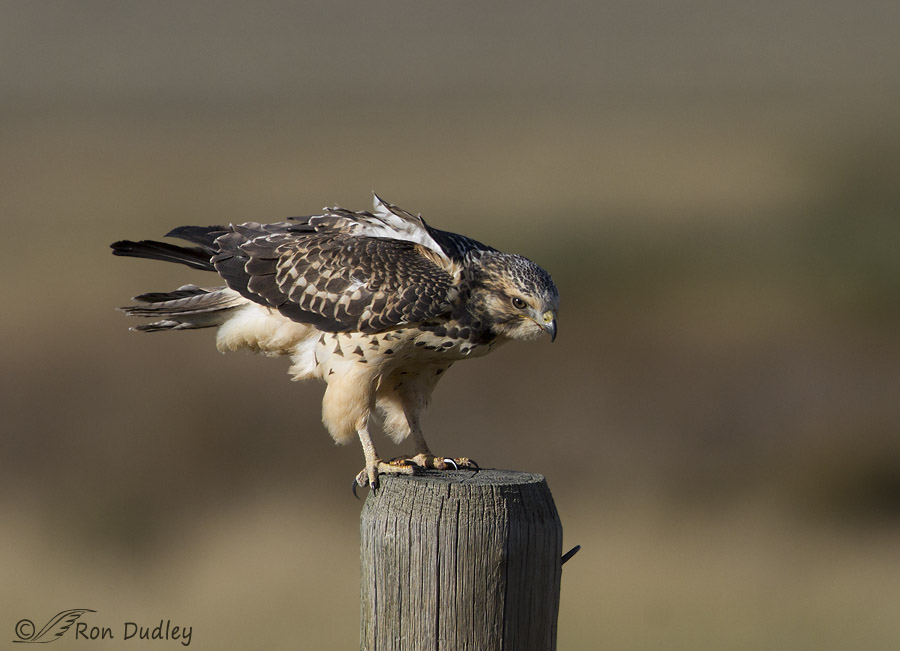
1/2500, f/7.1, ISO 500, Canon 7D, Canon EF500mm f/4L IS II USM +1.4 tc, not baited, set up or called in
I photographed the beautiful juvenile in early September in Montana’s Centennial Valley. Here the bird has just completed landing on the fencepost, has barely folded its wings and is about to stand erect.
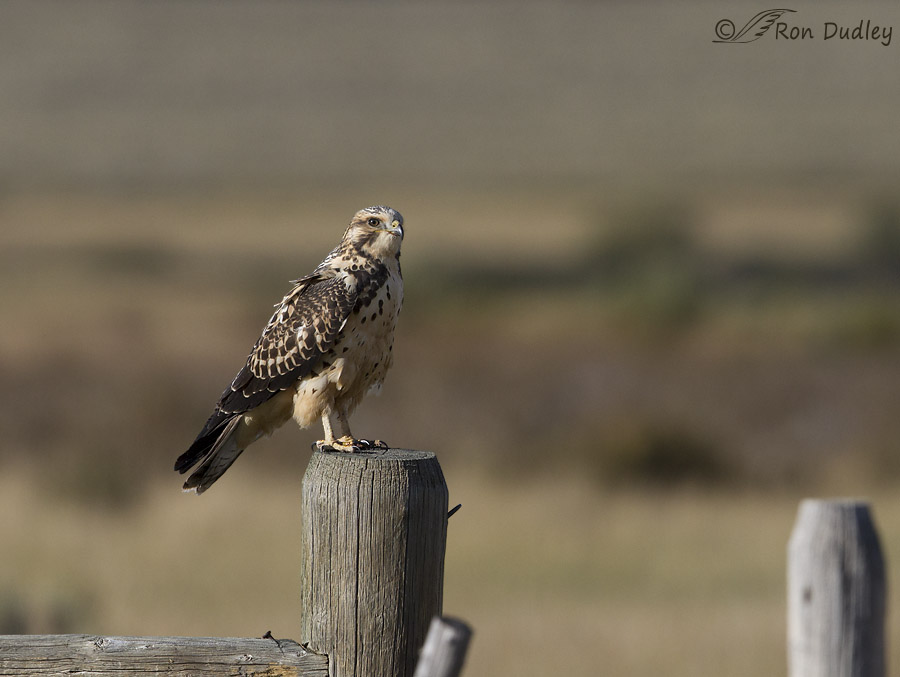
1/2500, f/7.1, ISO 500, Canon 7D, Canon EF500mm f/4L IS II USM, not baited, set up or called in
At that point I made the unfortunate decision to remove my 1.4 teleconverter (tc) so I would be less likely to clip or cut off any body parts when it took off again. If I hadn’t done so I’d have had better detail in the images that follow.
Note: Photographers may be interested in comparing these first two images to get a sense of the difference (in magnification) made by the teleconverter. I used the tc on the first image but not on the second. Both images have been cropped by the same amount (50% of the original image) and my shooting angle and distance to the subject are the same in both shots. You may also notice an increase in the ‘creaminess” of the backgound bokeh in the first image, as compared to the second, due to the first image having less depth of field.
OK, back to the point of this post…
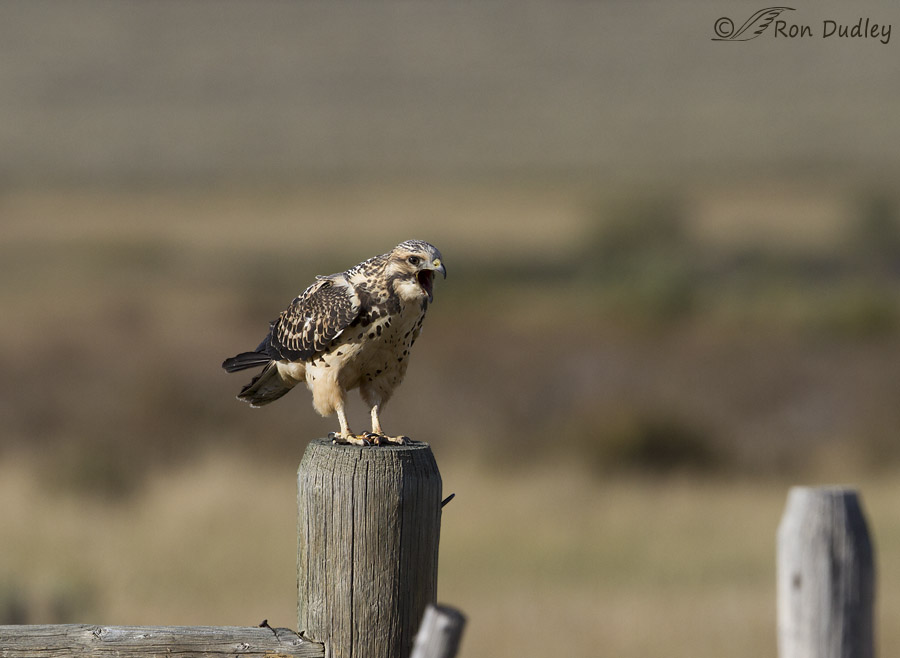
1/2500, f/7.1, ISO 500, Canon 7D, Canon EF500mm f/4L IS II USM, not baited, set up or called in
Eight frames later the hawk suddenly opened its mouth in what I assumed would be the retching behavior that often precedes the casting of a pellet (you can see the entire process of pellet casting by a Swainson’s Hawk here if you’re interested).
But this time both the bird and I were in for a surprise.
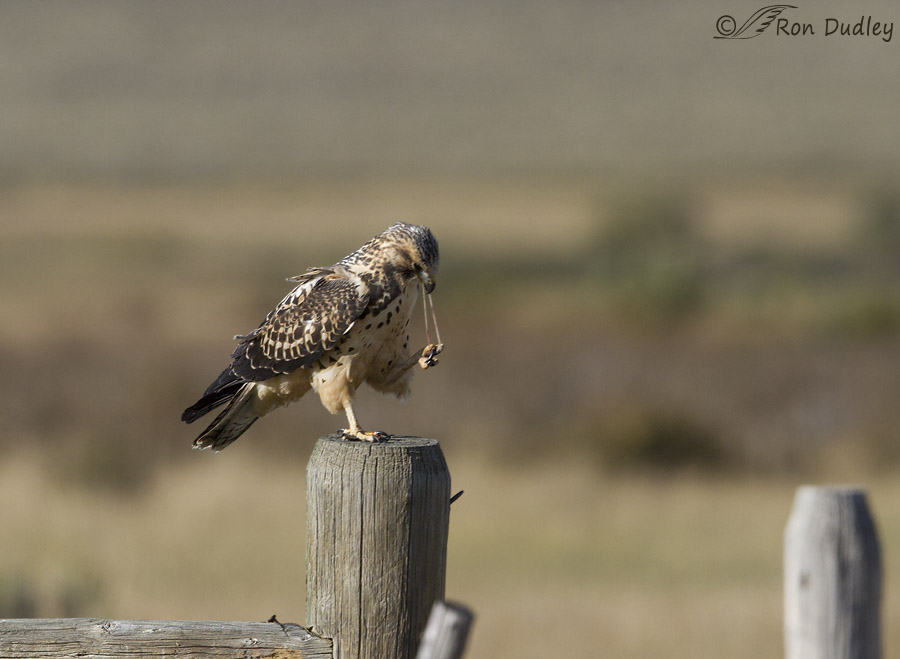
1/2500, f/7.1, ISO 500, Canon 7D, Canon EF500mm f/4L IS II USM, not baited, set up or called in
The hawk reached up to its mouth with its left foot and pulled this out! I can only assume it’s the small intestine of rodent prey that had been in its crop. One part of the intestine (or whatever it is) was looped between two of its toes and the bird struggled with it by pulling down, hard, with its left foot until…
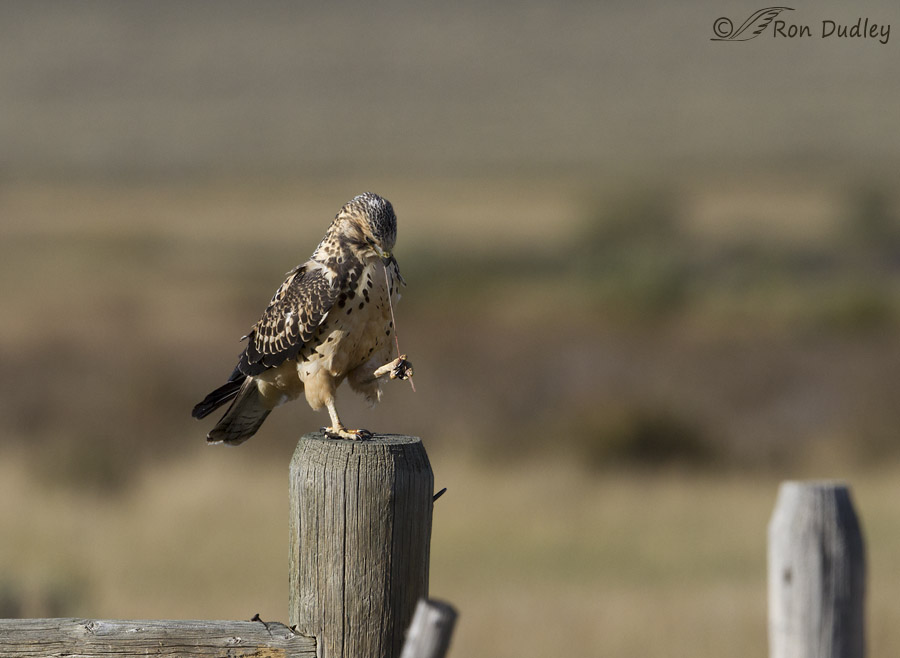
1/2500, f/7.1, ISO 500, Canon 7D, Canon EF500mm f/4L IS II USM, not baited, set up or called in
one of the two strands broke. Then it pulled some more until…
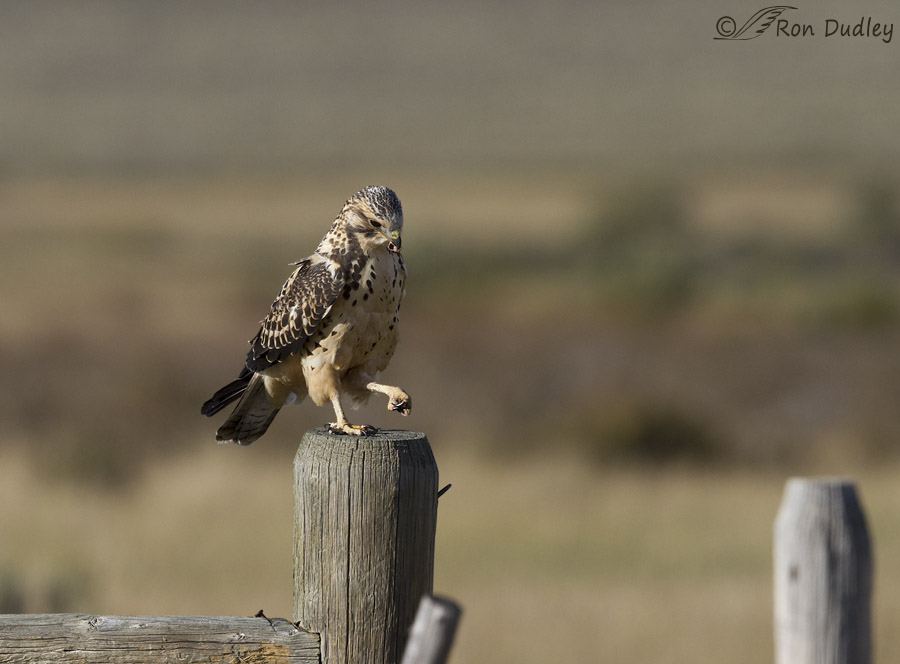
1/2500, f/7.1, ISO 500, Canon 7D, Canon EF500mm f/4L IS II USM, not baited, set up or called in
the other strand broke and snapped back into the face of the bird.
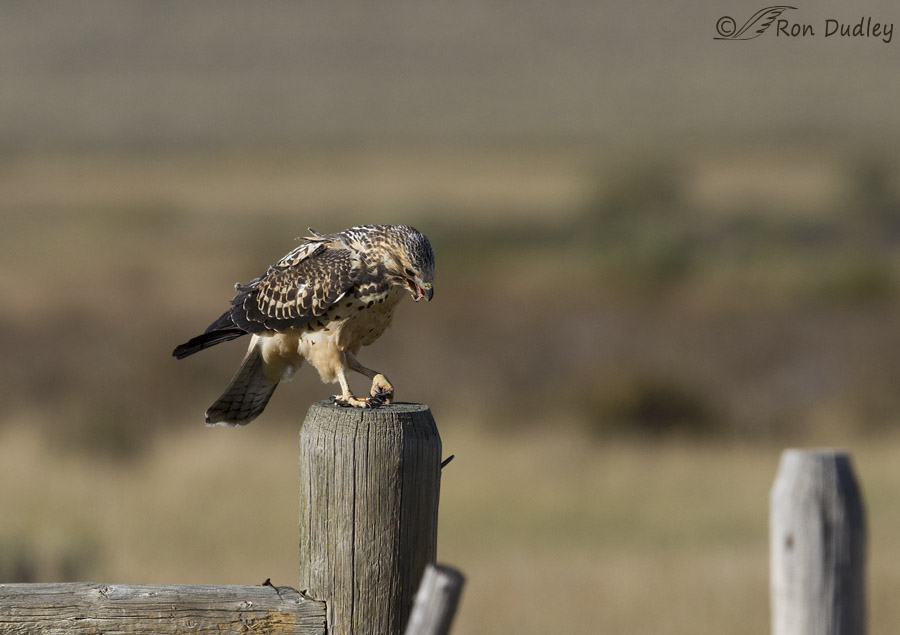
1/2500, f/7.1, ISO 500, Canon 7D, Canon EF500mm f/4L IS II USM, not baited, set up or called in
At that point the hawk swallowed the whole shootin’ match. Again.
If my assumption is correct that the food item was mammalian (or at least vertebrate) intestine then I’m slightly surprised because I’d been watching this bird for days and all I’d seen it eat was grasshoppers – although I know they also consume rodents and other prey, especially during the breeding season.
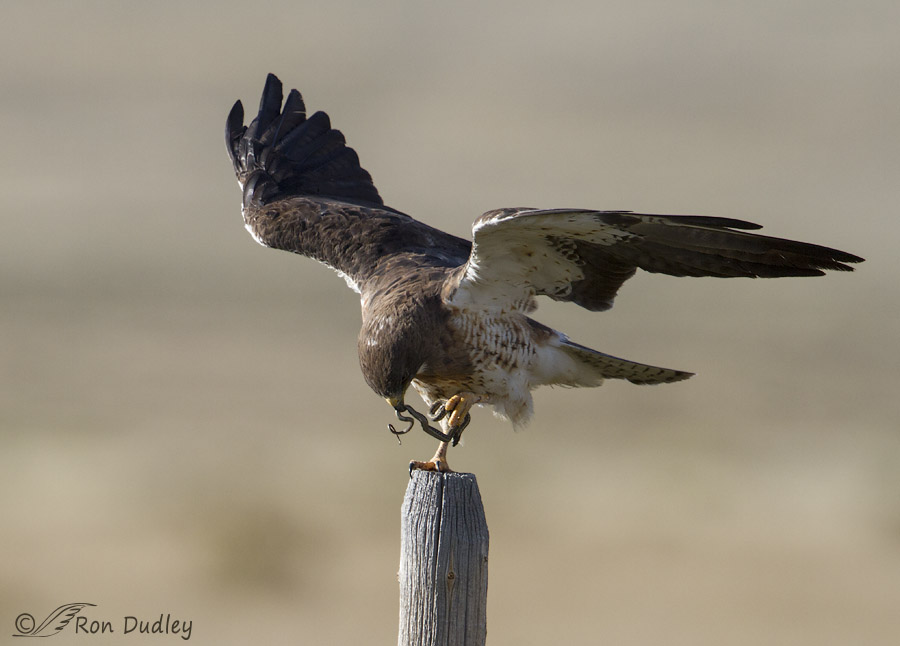
1/1600, f/7.1, ISO 500, Canon 7D, Canon EF500mm f/4L IS II USM + 1.4 tc, not baited, set up or called in
In fact, only 6 minutes earlier I had photographed one of the parents of the youngster as it struggled with and eventually ate this small snake. As to why the juvenile pulled the intestine(?) out of its crop, well… I’m stumped. Perhaps some of my readers (falconers or rehabbers perhaps) can provide some insight. It’s definitely something that I had never seen before. And haven’t since.
Ron


I was going to say, “Better out than in,”but…
So glad you felt up to posting and that your neighbors are pitching in during your recovery. 💕
Wow! It sounds like you are doing really well! Did you say earlier that they didn’t have to do as much as they thought? If you want to share, please let us know what they did. So happy to see your post-don’t overdo it! I speak from experience with my spinal fusions.
“Did you say earlier that they didn’t have to do as much as they thought?”
Yes, I did Judy. At first he was planning on fusing five different levels but once he got in there he decided I only needed to have four of them done. So he didn’t do L5-S1 as originally planned.
Very good photo of digestive behavior. I’ve went out with my falconry friends to assist in the hunt and I was surprised that the birds would choke down these large pieces of bone. They would use a pair of electricians dikes to cut the bones into more manageable size so they wouldn’t pierce there craw. I always thought that they just consumed the flesh off the bone. The gastric item might have wrapped around a item that is not as digestible.
Interesting that they used electricians’ dikes, Stephen.
Add me to the legions who say it is lovely to see a post from you, and even better to have a mostly positive update. Your back and my partner’s front must look much the same – a surgeon’s playground.
I feel for the hawk, and its prey. Suffice it to say I am not looking forward to breakfast. And very glad that it felt ready and able to consume those innards again. Deja vue as I don’t want to experience it.
EC, my incisions look a little like the stripes on a highway. Very different from my previous surgeries but of course I retain those scars too.
Excellent series and so interesting! Thank you for giving us an update on your back. We do want to know how you are healing and we are all rooting for you! Love your neighbors supporting you and Mia.
My neighbors are great. I remember the circumstances of meeting each one of them and they’ve been consistent in their wonderfulness for many years.
A wonderful series … I feel bad about 😂 at the shot taken when the stringy-thingy snapped back in poor Swainson’s face. I also feel bad about that pretty little snake meeting its demise at the talons of the adult, but what an amazing image that one is.
Glad you are managing so well already, and that you have those great neighbors—they can make all the difference when you live alone, whether you’re recovering from surgery or not!
Chris, I have help available at home but both of us appreciate the wonderful neighbors.
Thank you for your recovery update, and for making the effort to post this wonderful series. It must be a little unsettling to look at your back and see 13 surgical sites, but probably safer/easier to heal with many tiny ones than one large “Look, I had back surgery” opening. And thanks to your friends/neighbors who are keeping an eye on you!
Your note to photographers about the use of the teleconverter is interesting – I’m not a photographer, but it’s fascinating to see how you produce your art, and to see the difference between the two you describe.
The thought I had seeing the first stringy photo was “Oh no, Cat-string- foreign-body!” When cats play with and swallow stringy things – dental floss, thread, yarn, etc, it often winds up anchored under the tongue while the rest moves into the GI tract, pleating up the intestines. It’s a terrible situation for the cat – either surgery or death. So it was scary/interesting to read Buz’s comment – pretty much the same situation, but this beautiful bird was hopefully able to fix things itself. If it hadn’t, would the bits just sit in the crop until they were digested?
Thank you for the birds today, but don’t overdo it!
“it was scary/interesting to read Buz’s comment”
Buz knows what he’s talking about, Carolyn. He’s cofounder of Wildlife Rehabilitation Center of Northern Utah (WRCNU), the rehab outfit that cared for Galileo, the Short-eared Owl that I cut out of barbed wire. He and they do a lot of wonderful work. Friend and blog follower April Olson works for them too.
And I’m glad you found the photogeek stuff interesting.
I was delighted to see a post this morning, it must mean you are recovering well and faster than expected. Very interesting photos. I have no idea why, maybe the stingy parts got stuck and would not go down. Many birds don’t eat intestines and fling them all over while picking them out. Hard crap to scrape out of cages and kennels after it dries.
“Hard crap to scrape out of cages and kennels after it dries.”
I can imagine it is, April. And you’ve certainly done more than your share of it.
Here’s a possibility. Once in a while a raptor will get something wrapped around it’s tongue. Sometimes foreign sometimes food.
It’s very possible that rodent intestine got wrapped under or around the tongue when it swallowed allowing most of the attached food to go in the crop, but unable to fully swallow the last bit due to it still being around the tongue at one end and anchored in the crop by the bulk of it.
The only way out of that predicament is to attempt to bring it up and start over. Having (apparently) successfully broken the strand would allow it to finally go down the shute.
“Once in a while a raptor will get something wrapped around it’s tongue.”
I think that’s a strong possibility, Buz. I didn’t even think of it.
I’m a snake lover. That garter snake!!! But a hawk’s gotta eat! As to the intestinal tomfoolery? All I can say is “Stop playing with your food!!”
” “Stop playing with your food!!””
I guess it’s all part of being a youngster, Arwen.
Hey, I think he stole my flossing technique, although I usually manage to avoid getting blood on my toes.
Your thought processes are taking an interesting twist on the road to recovery to have hawked up these tasty morsels from the FP library.
You’ve got awfully decent neighbors there. Play your cards right and you might get them to do the laundry and some house cleaning. Can’t hurt to ask. On the other hand probably better not to push it.
Thirteen incisions? Was your surgeon using the hunt and peck method to locate things? I think that was popular in the 16th century.
Lyle, my surgeon used what I’d call a modified microsurgery technique which required many smaller inscisions rather than one huge one. At this point I’m a fan.
Sounds like you are making good progress and you sound optimistic and that is a positive sign. Really like the Swainson’s photos. I have never seen a juvenile. Handsome bird. Not surprised about the snapping back of the stretched intestine. Just like a rubber band I could see that coming. Love the last photo with the small snake.
Take care – don’t rush anything – and the healing will come.
PS: Really nice to see what your neighbors and friends are doing to help you.
Thanks, Everett. I have great neighbors!
Thoughts are with you as recovery continues. Don’t try to do too much too soon. (I sound like my mother.)
Another superb series of images! I’ve had the same issue with eating spaghetti. Especially that snap back hit you in the face part.
Observing nature continues to be so entertaining and even educational, whether we realize it or not.
Take care, Ron.
Thanks, Wally. I regularly practice that spaghetti-eating technique you describe.
Interesting! Wonder if if wasn’t grinding up like it should? Reminds me of stretching a rubber band too far……. 😉 Looks like the last bird has had some experience with snakes!
Glad you’re “progressing” and being well fed – makes a difference! 🙂 Just a slow process with all the “rootin’ around” they had to do.
“Rootin’ around” indeed. In photos of my back I believe I can count 13 new incisions and there may be more. There’s plenty of evidence of my surgeon’s rootin’.
I’m sure I speak for the rest of your followers when I say please do keep us informed as to your condition and progress toward wholeness. We care.
I’m new enough your site to appreciate you going back to republish some of you ‘best of’ photos. Love this set.
I practiced falconry for a few years in my youth. Have seen hawks bob their head around and do a yawning-like thing in what appears to be their effort to adjust the contents of the crop. Never saw anything like this though. But as you know, young birds sometimes do strange things. So great you caught this.
The hawk with snake photo is a gem.
Thanks, Michael. Yeah, maybe the crop contents were just uncomfortable to the bird so if felt the need to rearrange them.
GROSS ! But I’ll take it, because I’m glad to see that you’re feeling up to
posting– –you make your posse proud to see that you can keep on keepin’
on ……..
Kris, I won’t be “keeping on” on a daily basis for a while but I hope to post occasionally.
Enjoyed this slapstick comedy routine performed by a bird!!
Also, very glad you are feeling well enough to post to the blog. Keep the healing going!!!
Are you craving anything I can bake?? Just let me know. I can probably bake most anything you crave.
Yeah, you probably can, Sue. Thanks for the offer but I’m being pretty well taken care of and I’m actually looking forward to being able to cook again.
I’m very glad to hear that you are well enough to even think of posting photos again. It is also heartening to know you have good friends and neighbours looking out for you so well because good food equals good fuel for healing mentally, physically and emotionally from the trauma of any surgery.
The photos you choose being more prolonged and graphic than a pellet casting do make me slightly green but the behaviour itself is indeed interesting so I hope someone can shed some light on it.
The first and last shots are simply stunning. I am continually in awe of how organized you are to be able to pull shots like this out of the past but I guess that is probably a testament to good use of good software.
Much appreciated, Granny Pat. I don’t know how organized I am – it’s probably more of a testament to the way WordPress works, when it works. And the way my photo organizer works.
As interesting as the photo series is, that last photo of the hawk with the snake is a gem. Everything about it seems perfect, from the spread wings to the nice ‘spread’ of the snake’s coils that make it so obviously ‘snake.’ I’ve managed a couple of bird-with-snake photos, but in each of them the snake turned out to be more of a clump.
Thanks, Shoreacres. I haven’t had a lot of luck with raptor/snake photos either. Most of them are of documentary quality only, but I’m still happy to get them.